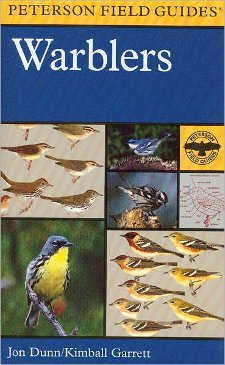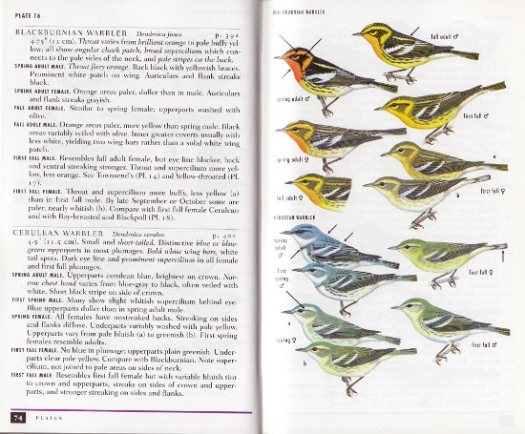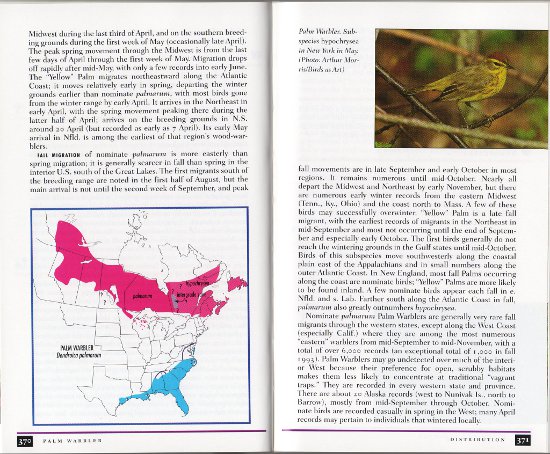Reviewed by Grant McCreary on December 9th, 2006.
I love warblers, and have since I first started birding. When I started, just in time for fall migration, I wanted to find all the warblers that I could. You may have heard the phrase “confusing fall warblers”? At that time, that described how I felt about most of the warblers I encountered. I needed some help, and turned to A Field Guide to Warblers of North America. And it’s still the first thing I refer to when I have a question about these wonderful birds.
Warblers includes 60 species of wood-warblers, focusing on those that have been recorded in North America north of the U.S./Mexican border. However, the authors have also included Baja California (and thus Belding’s Yellowthroat), as well as the two endemic warblers of the Bahamas – Bahama Yellowthroat and Bahama Warbler (here still treated as a subspecies of Yellow-throated Warbler). The guide is now 15 years old so, as you can imagine, the taxonomy is out-of-date. But that doesn’t impact its usefulness.
Illustrations
This guide includes both paintings and photographs. The paintings are bundled together in plates at the front of the guide. They depict just about all the different plumages for these birds, showing more variation than even The Sibley Guide. The plates utilize the “Peterson method” of arrows pointing out the best field marks, although you will still have to read the captions on the facing page to know what exactly is being pointed out (for example, is an arrow pointing at the supercilium in order to emphasize its presence, its color, or perhaps its shape?).
There are also separate plates that detail the under-side of the tail and the undertail coverts for all species. This is incredibly helpful given all the times that views such as this are the only ones you get in the field.
I love the art, especially the plates by Thomas R. Schultz. However, the plates seem to have been reproduced poorly in the printing process. Some images seem to be a little fuzzy, as if they were printed in too low of a resolution. And in many, you can see little dots/circles from the printing process. I don’t think this is a fault in the art itself. While going through some old Birding magazines from the American Birding Association, I found a preview for this guide, including a sample plate. Even though it was reproduced in the magazine larger than it is in the actual guide, it looked much better. This (seeming) printing flaw doesn’t impact the plates’ usefulness, but I have found it distracting.
All of the species accounts (except Belding’s Yellowthroat) include one or more color photographs. These are a great inclusion, but I found them to be a bit small and they suffer from the same printing malady as the plates.
Species Accounts
The accounts include:
- Introduction – most important characteristics; length in inches and centimeters
- Description
- Similar Species
- Voice
- Behavior
- Habitat
- Distribution – including migration timing
- Status and Conservation
- Subspecies
- Taxonomic Relationships
- Plumages and Molts
- References
These sections are very detailed, and will tell you just about anything you want to know about these birds.
The accounts also include one or more range maps, which show breeding, winter, and permanent ranges, along with limits of rare occurrence. The maps are large and detailed, even down to the county level in some cases. They also show subspecies ranges where appropriate. There’s even an entire map devoted to the Yellow-rumped Warbler interbreeding zone! The only thing these maps are missing is the migratory range. They’re bound to be a little out-of-date now, but are still very helpful.
Other than the printing quality, the only complaint I have with the Warblers Peterson guide is the size. The width and height are similar to that of most trade paperbacks, presumably to match the size of the other Peterson field guides. That serves to make the book very thick. If the dimensions could have been increased (perhaps to those used by the Princeton photographic guides) it would have reduced the thickness and also allowed the plates and photos to be reproduced in a larger size.
Recommendation
A Field Guide to Warblers of North America, though 15 years old now, is
still the best identification guide for our North American warblers, and one of the select few family ID guides that every birder should have in their library.
This review was updated May 9, 2012.
Update: While this Peterson guide is still worth having, what is written in the Recommendation above is no longer true. Subsequent to the last update of this review, The Warbler Guide was published, which now stands as the best guide to these birds.
Disclosure: I get a small commission for purchases made through links in this post.







[…] hover-glean: when prey is gleaned from a surface while the foraging bird is airborne A Field Guide to Warblers of North America […]
[…] the soft wing bars – may be a pine warbler. They come to feeders in the winter and my book (Peterson Field Guides, Warblers) says they like bread crumbs, suet and sunflower […]
[…] Dunn and Kimball Garrett optimistically included the Bachman’s in their 1997 field guide to warblers for the Peterson series, although it hadn’t been seen at all since 1988. They describe it as […]